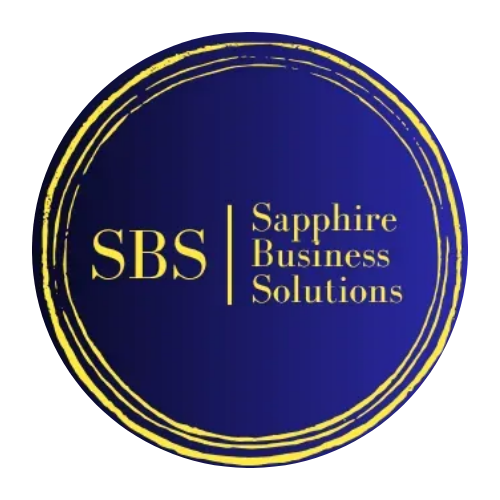Sapphire Business Solutions
Beyond Bookkeeping: Compliance, Tax Prep & Notary in One Subscription
Your trusted compliance and bookkeeping partner for small businesses in Alabama.
100% Compliance Guarantee
Bonded & Insured
Serving Businesses Since 2000
IRS & State Certified
Business Partnership Packages
Transparent pricing. Maximum value. All-in-one business support.
Essential
- Monthly Bookkeeping
- AP/AR Tracking
- Annual Compliance Filing
- 1 Notary Session/mo
- Basic Tax Prep (Individual)
Growth
- All Essential Features
- Quarterly Tax Reviews
- 4 Notary Sessions/mo
- Business Tax Prep
- Records Management
Premium
- All Growth Features
- Dedicated Account Manager
- 10 Notary Sessions/mo
- Audit Prep Support
- Payroll Setup + 3 Months
Trusted by Entrepreneurs
Real results. Real peace of mind.
"I don't stress about tax season anymore, my books are always ready."
Doug
Real Estate Investor
"I have used Sapphire Taxes for the past couple of years for personal and business returns. The owner, Shemea, is extremely professional, personable, and knowledgeable. The company website is very user friendly and communication is quick, clear, and concise at all times. Shemea does not shy away from any questions and is very patient in explaining all details and making sure the best options and decisions are being made for her clients. Her thoroughness and attention to detail are impeccable and she is very consistent. I will gladly recommend anyone to work with Sapphire Tax & Signing Services if you are looking for someone you can trust."
Erica M
Business Owner
"I recently had the pleasure of working with Sapphire Taxes & Signing Services LLC, and I must say, my experience exceeded all expectations. From the moment I reached out for assistance with both my tax filing, the team was professional, knowledgeable, and incredibly responsive.In conclusion, I highly recommend Sapphire Taxes & Signing Services LLC to anyone in need of reliable, professional, and personable tax and notary services. Their attention to detail, professionalism, and outstanding customer service truly set them apart. I’ll definitely be returning for future tax filing needs and would recommend them to friends and family without hesitation."
Ken O.
Tax Client
About Sapphire Business Solutions
Founded by Shemea (Mea) Broom, IRS recognized tax preparer, commissioned notary public, and compliance specialist; Sapphire Business Solutions was born from a simple mission: Clarity, trust, and predictable growth for small businesses.
With over 25 years of experience in Alabama business regulations, tax law, and financial compliance, we understand the unique challenges local entrepreneurs face.

Mea Broom
Founder & Lead Advisor
"After helping businesses navigate complex compliance issues for over a decade, I realized small businesses needed an integrated solution, not just bookkeeping, but true partnership."
Our Integrated Services
One subscription. End-to-end business support.
Bookkeeping
Monthly financial reports, AP/AR tracking, reconciliation, and insights.
- Monthly Reporting
- AP/AR Management
- Bank Reconciliation
- Financial Insights
Compliance Filing
Annual reports, business licenses, state registrations, and regulatory updates.
- Annual Reports
- Business Licenses
- Entity Filings
- Audit Readiness
Notary Services
Mobile, remote ink, or in-office notarization, included in every plan.
- Mobile Notary
- Remote Online
- In-Office
- Document Authentication
Records Management
Secure digital vault for contracts, licenses, tax docs, and audit trails.
- Document Storage
- Version Control
- Access Permissions
- Retention Policies
Comprehensive Tax Solutions
Stress-free filing for individuals and businesses — with deduction optimization and compliance assurance.
For Individuals
Personalized tax preparation with maximum deductions
- Annual Federal & State Tax Preparation
- Amendment & Prior-Year Filings
- Extension Requests & Filing
- Deduction & Credit Optimization
- Retirement Contribution Planning
For Businesses
Strategic tax planning for business growth
- Quarterly Tax Preparation Reviews
- Estimated Tax Payment Guidance
- Entity-Specific Compliance Filing
- K-1 & Partnership Reporting
DIY Taxes
Handle your taxes yourself; with expert guidance available.
- Secure Document Upload & Review Portal
- Personalized Tax Organizer Templates
- Confidence You’re Filing Correctly, Not Just Alone
Certified Loan Signing Services
Professional, reliable, and fast - whether it's real estate, mortgage, or business financing.
Flexible Hours
Monday–Saturday
8 AM - 6 PM and after-hours available from 6 PM - 8 PM
Mobile Notary
We come to you - home, office, or closing site
Bonded & Insured
Alabama Notary Public
E&O Insurance
Trusted by Real Estate Professionals
Get in Touch with Sapphire
Whether you need compliance support, tax prep guidance, or notary services — we’re here to help. Reach out today and let’s simplify your business journey.
Contact Information
(205) 235-2373
Call us Mon–Sat, 9am–5pm CT - real people, real answers.
info@sapphiretaxnotary.com
Email replies within 24 hours guaranteed.
Birmingham, AL
Serving all of the Birmingham Metro
Send a Message
Fill out the form and our team will respond within one business day.
